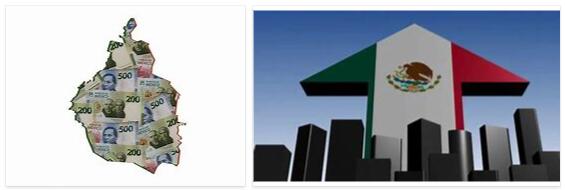Economy and well-being
The Latin American Tower (182 m) is one of the tallest buildings in Latin America and is a symbol of the economic development of the Mexican capital and of the nation.
The Federal District has been, for much of the history of independent Mexico, its main economic center. In the 19th century, the peripheral municipalities of the entity had an economy based on agriculture and the trade of the goods produced by this activity and other complementary manufactures. Both agricultural products and obrajes were consumer goods whose main point of commerce was Mexico City. This, due to its character of national capital, specialized in the provision of services associated with the public administration. Some of its residents were also agricultural workers, but almost all of them were concentrated in the service sectors and nascent industry.
During the 19th century, the main industrial activities in the Federal District were the textile and paper industries.
At the end of that century, during the Porfirian government, mechanical looms were introduced in factories such as La Magdalena or La Fama, while paper production flourished in Peña Pobre and Loreto. The capital’s industry was transformed until well into the 20th century, when a model of import substitution was promoted. Between the 1950s and 1980s, the Federal District produced up to 36% of the national nominal GDP. [24] However, since then the Federal District has lost importance in the national GDP: at the beginning of the 21st century, it only represented 25% of the total.
Similarly, the Federal District employed 45% of the workers in the manufacturing industry in Mexico in 1980, but a decade later, the proportion had fallen to 33%. Of the five hundred most important companies in the country, in 1982 it housed 257 of them. Seven years later, only one hundred and forty-five remained in the Mexican capital.
The decline in industrial activity in the Federal District implied, on the one hand, the growth in relative terms of the income contributed by the tertiary sector (services), and on the other hand, it was also reflected in the growth of the informal economy in the city. Despite all these setbacks, after the crisis in the Mexican economy of the 1980s and 1990s, the Federal District was one of the few states whose participation in the national GDP improved. It went from 21% in 1988 to 23% in 1996. In addition, per capita income increased, due in part to the demographic contraction resulting from the 1985 earthquake.
In 2004 it produced 20.52% of the national gross domestic product (GDP), which is equivalent to almost 133,000 million dollars. The city’s GDP per capita is also the highest in Mexico, estimated at US $ 18,381. This figure is equivalent to 2.5 times the national GDP per capita, and is similar to that of countries such as Portugal, Estonia, Puerto Rico and Barbados.
According to a study carried out by PricewaterhouseCoopers, Mexico City and its metropolitan area occupy the eighth place of the richest cities in the world, having a GDP of 331,000 million dollars that will double, according to the same study, by 2020, placing it in seventh place only behind Tokyo, New York, Chicago, Los Angeles, London and Paris.
Main auditoriums and theaters
The Cuban company Danza Contemporánea de Cuba at the premiere of its work Carmina Burana at the National Auditorium of Mexico in November 2008
- The National Auditorium is only surpassed in capacity (15,000 seated spectators) by Madison Square Garden in New York.
- The Palace of Fine Arts
- The Polyforum Cultural Siqueiros
- The City Theater
- The Metropólitan Theater
- The Insurgentes Theater
- The Sun Forum
There are also several experimental theaters and smaller auditoriums, which are used by theater students and schools; such as the El Granero Theater, located behind the National Auditorium, where there are other theaters with less capacity for spectators. Likewise, there are some theaters sponsored by the Mexican Institute of Social Security as part of its cultural activities for the general public and its members. Mexico City is the fourth city with the largest number of theaters.
Parks and forests
Mexico City has several parks and forests, some of which are protected nature reserves, which make a high contrast with buildings and trees, some of the main parks and forests located throughout the Metropolitan Area of Mexico City are:
- The Forest of Tlalpan.
- The Chapultepec Forest and Zoo (this being the largest in Latin America).
- The Forest of Aragon.
- The Coyote Forest
- The Sunken Park.
- Xochimilco Park.
- The Hill of the Star.
- The Desierto de los Leones National Park.
- The Sierra de Guadalupe Natural Park.
Similarly, there are a large number of parks, squares and gardens throughout the city, with an extraordinary beauty each and every one of them.
